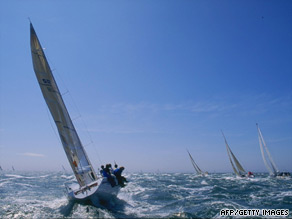
It is still remembered as one of the worst days in the history of modern sailing.
Yet the Fastnet tragedy of 1979 in which 15 people were killed and ex-British leader Edward Heath went missing helped to usher in a new era of improved safety in the sport. It was 30 years ago today that a freak storm struck over 300 vessels competing in the 600-mile yacht race between England and Ireland. Mountainous seas and vicious high winds sunk or put out of action 25 boats. The British rescue attempt turned into an international effort with a Dutch warship and trawlers from France also joining the search. In spite of the biggest rescue operation launched by the UK authorities since the Second World War a total of 15 people died. Some of them drowned and others succumbed to hypothermia. Six of those lost went missing after their safety harnesses broke. “It was a catastrophic event that had far-reaching consequences for the sport, the biggest of which was in the design and safety of the boats,” Rodger Witt, editor of the UK-based magazine Sailing Today told CNN. “Most people in the sailing community at the time knew someone who was involved in one way or another. I had a friend who lost his father. It was devastating.” In total 69 yachts did not finish the race. The former British prime minister, Edward Heath disappeared at the height of the storm, though he later returned to shore safe from harm. The corrected-time winner of the race was the yacht “Tenacious”, owned and skippered by Ted Turner, the founder of CNN. Witt said that in the aftermath of the disaster the rules governing racing were tightened to ensure boats carried more ballast. Improvements were also made to the safety harnesses that tied crewmen to their boats, many of which proved ineffective in the tragedy. It also became mandatory for all yachts to be fitted with radio communication equipment and all competitors were expected to hold sailing qualifications to take part. At the time of the tragedy the Fastnet race was the last in a series of five races which made up the Admiral’s Cup competition, the world championship of yacht racing.
Don’t Miss
Yachting: No sport for the faint-hearted
‘Sail-plane’ to attempt world speed record
Norman Foster’s superyacht
Competitors from around the globe attempted the route which sets off from the Isle of Wight, off the English south coast, and rounds the Fastnet rock on the southeast coast of Ireland. Roger Ware was in charge of handling press for the event on behalf of the organizers, the Royal Ocean Racing Club. Ware said that even today the tragedy “still spooks me.” The racers set off on a Saturday but it wasn’t till three days later that the authorities in the English coastal town of Plymouth realized there was a problem. The press team was based at the Duke of Cornwall hotel in Plymouth and early Tuesday morning Ware got a call from his superiors to go to the hotel immediately in order to field calls from journalists. “The night before we’d noticed high winds but there’d been no forecast of bad weather so we didn’t think much of it,” Ware told CNN. “As the morning progressed though, we heard that more and more boats were missing. It became obvious a tragedy was unfolding.” Ware said the worst part for him was fielding calls from concerned relatives. “The Royal Ocean Racing Club headquarters was overloaded so calls were getting transferred to the press team. “I found myself talking to a woman whose husband I knew was in one of the boats where there’d been fatalities. I couldn’t give her the information she wanted and to this day I still think about that telephone call.”